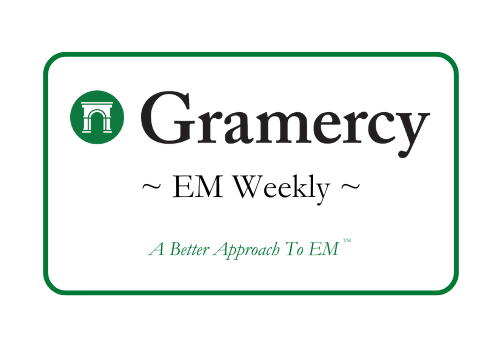Contents
Market Overview
Macro Update
This week, the Fed unsurprisingly left policy rates unchanged amid increasing worries about an economic slowdown in the U.S., Germany passed a historic spending package, and Türkiye detained an opposition leader, triggering turmoil in its markets.
The FOMC’s statement and revised projections leaned toward stagflation, as expected, with a downward revision to this year’s growth estimate, to 1.7% from 2.1%, and an upward revision to this year’s PCE forecast, to 2.8% from 2.5%. The unemployment rate forecast for 2025 was lifted by 10bps to 4.4%. The median dot moved slightly less dovish but still reflected two cuts this year, and the pace of quantitative tightening (QT) will slow in April. Federal Reserve Chairman Jerome Powell’s press conference reassured markets as he implied the inflationary impact of tariffs might be transitory and downplayed the recent string of worrisome survey measures. He emphasized inertia amid uncertainty and struck a sanguine tone on growth and labor markets. He also stated that recession odds have moved up but are not high.
The combination of a hawkish FOMC statement and dovish press conference is not a new feature of this Fed. U.S. Treasury yields moderated, and equities bounced higher during the press conference.
U.S. data this week were mixed with lower-than-consensus, sequential retail sales growth and a sharp drop in the Empire State Manufacturing Survey. These were offset by a robust jump in housing starts and existing home sales, better month-on-month industrial production, and initial jobless claims roughly in line with expectations. At the end of the week, the Philadelphia Fed data brought back the whiff of stagflation.
In Europe, Germany’s historic spending package passed in Parliament, removing the cap on borrowing related to defence spending and establishing a EUR 500 billion fund for infrastructure and climate spending. Focus will now move to the government formation process, policy implementation, and the overall reform agenda.
In the UK, the Bank of England kept rates on hold as expected amid worsening budget borrowing data for February. On the data front, final headline February CPI for the eurozone came in a smidge softer than expected at 2.3% year-on-year, while core came in line with expectations at 2.6% year-on year. The EUR was flat on the week as much of the fiscal news was priced in and U.S. equities got a boost post FOMC, supporting DXY.
The U.S. and Russia reached a 30-day agreement on cessation of long-range air attacks on energy infrastructure but fell short of reaching a broader ceasefire. Ukraine backed the agreement in the aftermath. Further talks on details of the partial ceasefire, including the safety of Black Sea shipping, are set to continue in Saudi Arabia next week. Meanwhile, Moscow pushed back against ongoing European efforts to form a “coalition of the willing” to deploy peacemakers in Ukraine following any full ceasefire, highlighting the challenges to a durable near-term peace. Ukrainian euro bonds were down on the week.
China’s central government launched another campaign to boost consumption, which entailed direct subsidies, income and stock market support, as well as country expansion for visa-free entry. While a step in the right direction, consumption-oriented fiscal outlays outlined at the National People’s Congress (NPC) remain modest. Equity markets and bond yields ended the week slightly lower. In Japan, February inflation came in 20bps above expectations at 3.7% year-on-year.
The Central Bank of Türkiye increased the upper bound of its policy rate corridor by 200bps, effectively delivering monetary policy tightening of 300-350bps via its overnight lending rate. This helped contain TRY depreciation on the back of President Recep Tayyip Erdogan’s opposition crackdown and arrest of Istanbul Mayor and rival Ekrem Imamoglu. In line with consensus, Brazil increased its policy rate by 100bps while South Africa left rates unchanged.
The U.S. attacks on Houthi rebels in Yemen, as well as resumed Israeli strikes on Gaza, broke a period of relative calm. Oil prices continued to look through the escalation, but the risk of retaliatory strikes poses upside risk to prices in the coming weeks.
EM Credit Update
EM fixed income markets were up on the week, with EM hard currency sovereign and corporate returns of 0.6% and 0.3%, respectively. Spreads narrowed by -1bps and widened by 3bps, respectively. In the sovereign space, investment grade returns of 0.7% outperformed high yield returns of 0.5%. Similarly, corporate high yield returns of 0.2% lagged corporate IG returns of 0.4%. Amid moderate dollar recovery, EM local currency sovereign bonds were down 0.2% on the week.
Türkiye local bonds were the main underperformer on the week down 10.3% amid President Erdogan’s political crackdown.
In the hard currency space, Venezuela and Rwanda outperformed on the week. In Venezuela, prospects for an extension of Chevron’s license to operate in the country lifted bonds, while Rwanda and the Democratic Republic of Congo reached an agreement for a ceasefire. Bolivian bonds lagged as fuel shortages and associated subsidies drove concerns over the fragile macroeconomic position.
There were no new sovereign issues this week, but corporate activity remained steady, with 27 deals coming to the market across EM regions.
The Week Ahead
In the U.S., a fresh batch of macroeconomic data – including March preliminary PMI, house prices, consumer confidence, new home sales, PCE, and University of Michigan’s inflation expectations – should provide additional insight on the health of the economy.
In Europe, eurozone and German preliminary March PMI and consumer confidence will be in focus, as will UK PMI, inflation, 4Q real GDP, retail sales and the Spring Fiscal Statement.
In Asia, data flow will be light with China industrial profit growth and India March PMI.
Elsewhere in EM, Mexico’s Central Bank is expected to continue its easing cycle with a 50bps cut, while the Central Banks of Hungary and the Czech Republic are expected to keep policy rates on hold.
Fixed Income
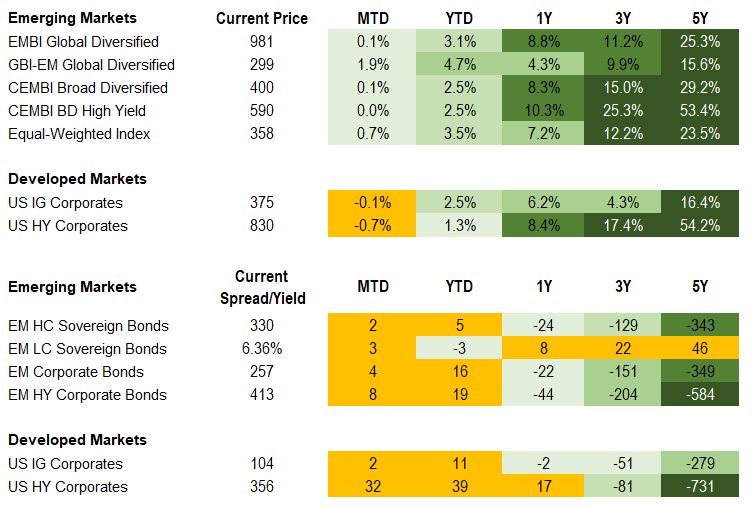
Equities
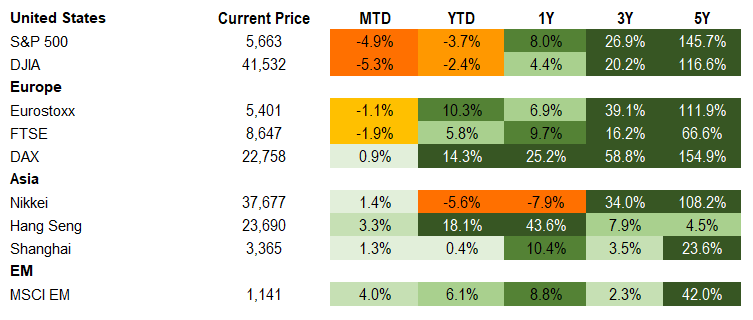
Commodities

Source for data tables: Bloomberg, JPMorgan, Gramercy. EM Fixed Income is represented by the following JPMorgan Indicies: EMBI Global, GBI-EM Global Diversified, CEMBI Broad Diversified and CEMBI Broad High Yield. DM Fixed Income is represented by the JPMorgan JULI Total Return Index and Domestic High Yield Index. Fixed Income, Equity and Commodity data is as of March 21, 2025 (mid-day).
Country Highlights
Turkish Authorities Demonstrate Willingness to Manage Market Stress
Event: The arrest of Mr. Imamoglu, a top political rival of President Erdogan, escalated market concerns about a broadening crackdown on the Turkish opposition. Mr. Imamoglu, Istanbul’s Mayor, is now facing charges including corruption and support of terror organizations but enjoys high popularity domestically. His detention on Wednesday triggered a sharp sell-off in Turkish assets that has gradually eased since then. Volatility was particularly notable in TRY as technical issues delayed the Central Bank’s intervention in support of the currency. Eventually, authorities were able to correct the technical problems and stabilize the FX at an estimated cost of selling $8 – $10 billion of reserves to meet hard currency demand, mostly from international investors unwinding long TRY carry trades. On Thursday evening, after local markets closed, the Central Bank of Türkiye delivered a 200bps hike in the overnight lending rate, which amounts to an effective monetary tightening of between 300 – 350bps, in a strongly reassuring signal to markets that should support the TRY.
Gramercy Comment: This week’s volatility episode in Turkish markets was triggered by two factors: political risk and the unfortunate technical obstacles that prevented a timely, full-fledged intervention by the Central Bank that could have prevented the extreme volatility. In the near-term, these developments could elevate the risk premium that investors demand to hold Turkish assets. However, whether they lead to any more permanent or significant economic or market damage depends on the authorities ability to reassure local corporates and households that the macro adjustment program implemented in late 2023 remains on track. In addition, any sign pointing to re-dollarization of local bank deposits is one to monitor.
Absent any pressures in that direction, we are of the view that with around $160 billion in gross FX reserves, and net reserves that have seen an improvement of around $140 billion over the last year-and-a-half, the Central Bank has sufficient ammunition to manage FX pressures arising from political developments. Moreover, we believe that authorities remain strongly committed to disinflation and even to enhancing the macro stabilization program, as confirmed by the Central Bank’s reaction on Thursday when it tightened monetary policy by hiking the upper band of its policy rate corridor. Following this action, our base case now is that the Turkish Central Bank will stay hawkish in the four weeks until the next monetary policy meeting in April and will pause the rate cutting cycle. This should further ease market anxiety and would be TRY supportive. Overall, we believe that the political shock to Türkiye’s macro adjustment is more likely to be transitory and will not derail progress. The risk is that local sentiment turns negative on the back of political protests erupting, prompting a flight from TRY by locals. We will be monitoring closely for any red flags on that front.
Potential Shift in U.S. Approach to Chevron Operations in Venezuela
Event: The WSJ reported that the U.S. is open to a possible extension of Chevron’s license to operate in Venezuela, which currently expires on April 3rd. An extension may include imposition of tariffs or financial penalties on other countries that buy oil from Venezuela, notably China. This could serve to prevent those countries from getting a foothold in Venezuela and keep oil flowing to the U.S. The report came on the heels of U.S. President Donald Trump’s meeting with Chevron’s CEO and other oil executives. Earlier in the week, Venezuela state oil company PDVSA announced plans to continue production at the Chevron field, while the U.S. reiterated that Venezuelan leader Nicholas Maduro must accept deportation flights.
Gramercy Comment: Consideration of a more creative, U.S. creditor-friendly approach to Venezuela is a move in the right direction. It remains to be seen if this can be done while also satisfying those in the “maximum pressure” camp, particularly in the short-term. In this vein, we expect the Trump Administration to continue to adopt an outwardly hardline stance and possible punitive action against Mr. Maduro, but we also think it is possible that the wind-down period of Chevron’s license is extended while a strategy is developed further.
Argentina IMF Decree Upheld but Trade Surplus Underperforms
Event: The lower house of Argentina’s Congress voted to uphold President Javier Milei’s emergency decree regarding the IMF program, paving the way for eventual staff and board level agreements with the Fund. Also this week, the February trade surplus disappointed at $227 million vs. the consensus of $750 million, largely on robust import growth as the economy recovers. The gap between Argentina’s parallel and official exchange rate widened moderately, to just above 20%.
Gramercy Comment: The fact that Argentina’s Congress did not reject the decree is positive and supports the base case view that an IMF deal will be concluded in the coming months. The lackluster trade surplus, amid the surge in imports, is mixed. It reflects a robust economic recovery and the likely associated support for President Milei into the midterm elections later this year. It also underscores external risks in the context of a more challenging international backdrop, an overvalued FX rate and a likely moderate deterioration in the current account balance. However, lingering and rebuilding external imbalances are not as severe compared to past periods of elevated external risks.
Emerging Markets Technicals
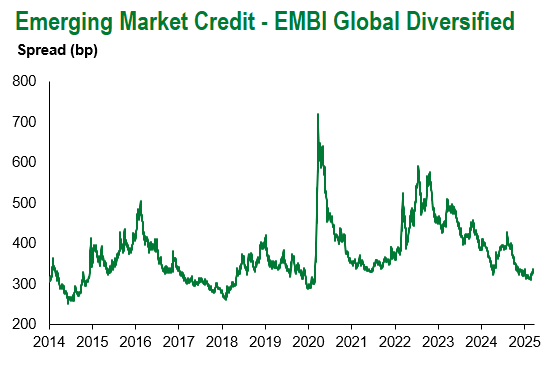
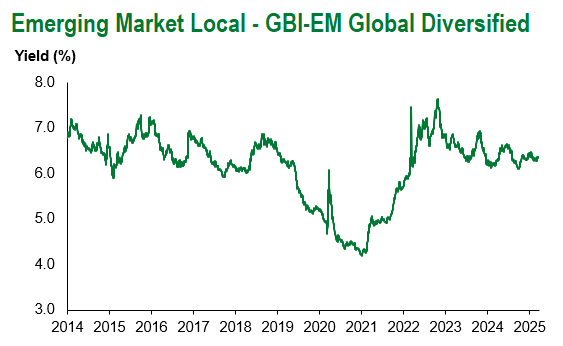
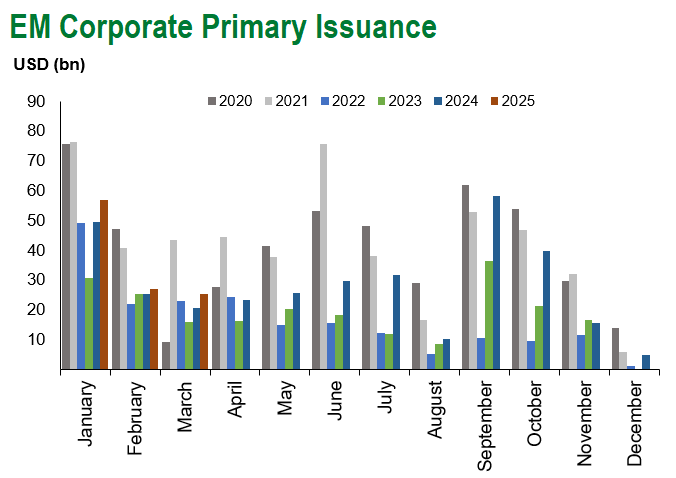
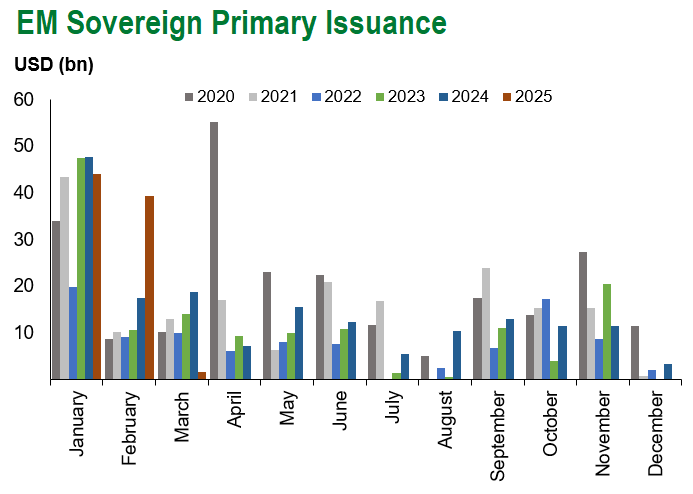
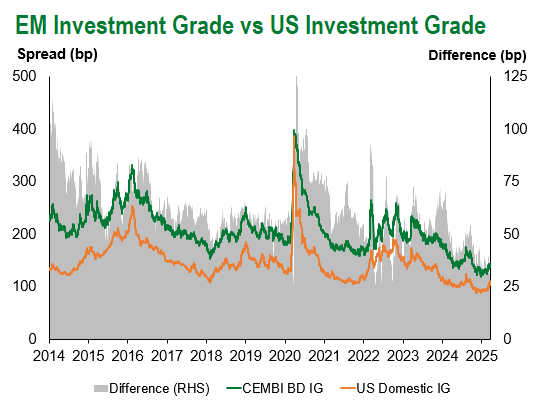
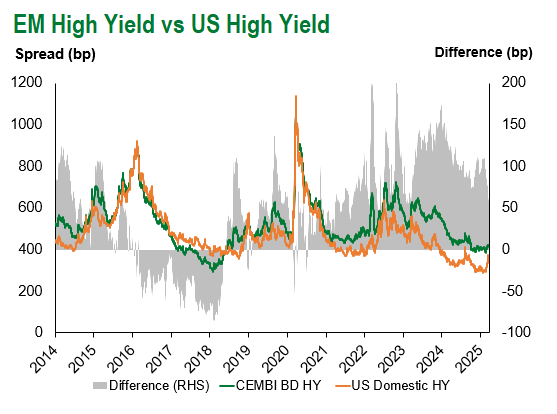
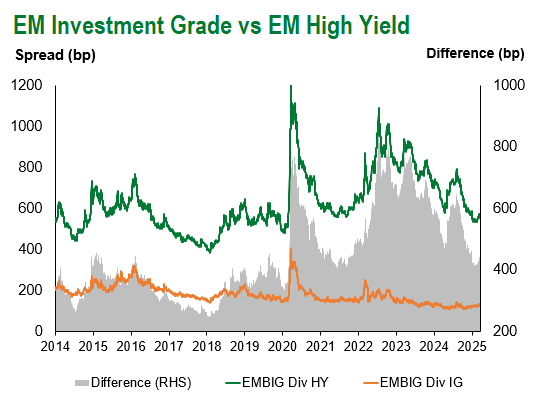
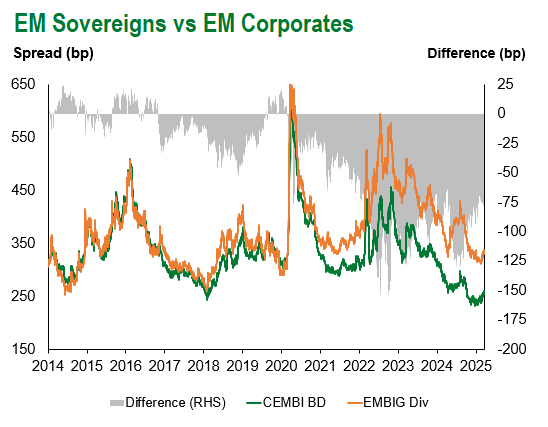
Emerging Markets Flows
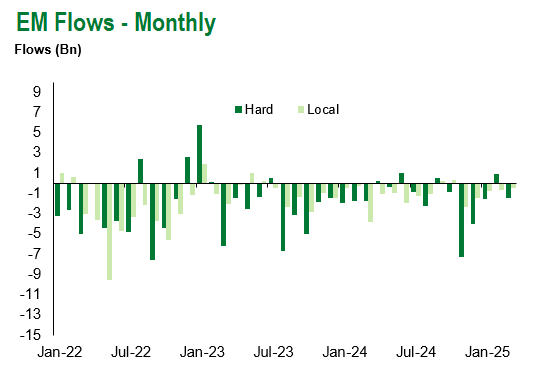
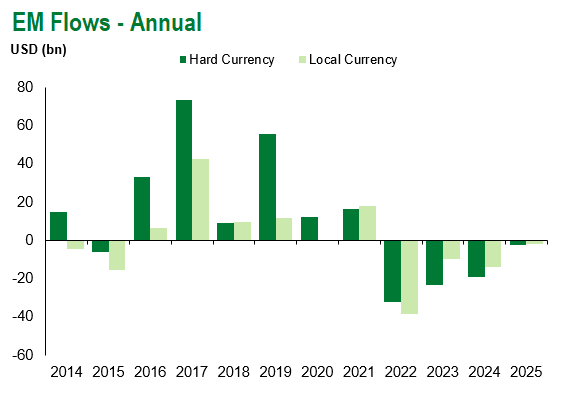
Source for graphs: Bloomberg, JPMorgan, Gramercy. As of March 21, 2025.
For questions, please contact:
Kathryn Exum, CFA ESG, Director, Co-Head of Sovereign Research, [email protected]
Petar Atanasov, Director, Co-Head of Sovereign Research, [email protected]
This document is for informational purposes only. The information presented is not intended to be relied upon as a forecast, research or investment advice, and is not a recommendation, offer or solicitation to buy or sell any securities or to adopt any investment strategy. Gramercy may have current investment positions in the securities or sovereigns mentioned above. The information and opinions contained in this paper are as of the date of initial publication, derived from proprietary and nonproprietary sources deemed by Gramercy to be reliable, are not necessarily all-inclusive and are not guaranteed as to accuracy. This paper may contain “forward-looking” information that is not purely historical in nature. Such information may include, among other things, projections and forecasts. There is no guarantee that any forecasts made will come to pass. Reliance upon information in this paper is at the sole discretion of the reader. You should not rely on this presentation as the basis upon which to make an investment decision. Investment involves risk. There can be no assurance that investment objectives will be achieved. Investors must be prepared to bear the risk of a total loss of their investment. These risks are often heightened for investments in emerging/developing markets or smaller capital markets. International investing involves risks, including risks related to foreign currency, limited liquidity, less government regulation, and the possibility of substantial volatility due to adverse political, economic or other developments. References to any indices are for informational and general comparative purposes only. The performance data of various indices mentioned in this update are updated and released on a periodic basis before finalization. The performance data of various indices presented herein was current as of the date of the presentation. Please refer to data returns of the separate indices if you desire additional or updated information. Indices are unmanaged, and their performance results do not reflect the impact of fees, expenses, or taxes that may be incurred through an investment with Gramercy. Returns for indices assume dividend reinvestment. An investment cannot be made directly in an index. Accordingly, comparing results shown to those of such indices may be of limited use. The information provided herein is neither tax nor legal advice. Investors should speak to their tax professional for specific information regarding their tax situation.
